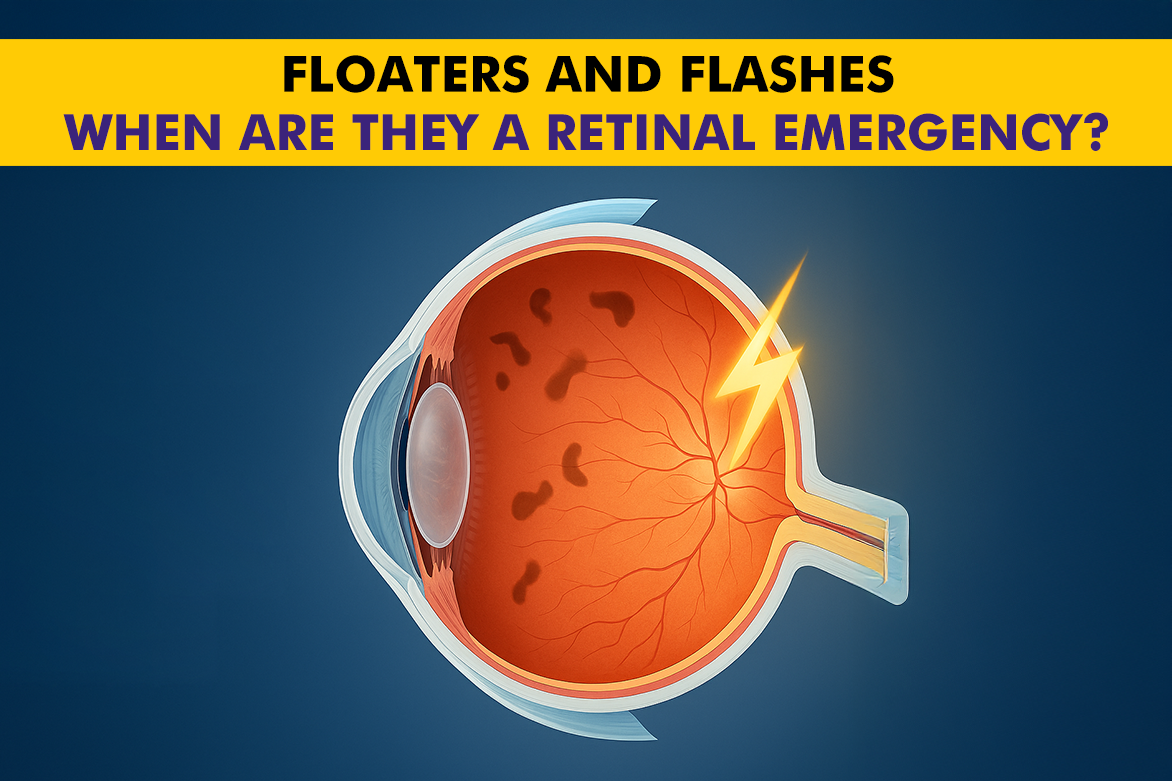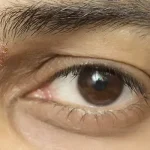Table of Contents
- What Are Floaters and Flashes in the Eye?
- Are They Always Serious?
- When to Be Concerned: Warning Signs of a Retinal Emergency
- Understanding Retinal Detachment
- Diagnostic Steps and Eye Examination
- Immediate Treatment Options
- Preventive Measures and Monitoring
- Conclusion
- FAQs
Did you ever give attention to tiny specks drifting across your vision? Or seen flashes of light when turning your head quickly or walking into a dark room? These are known as eye floaters and flashes. While they are quite common, especially as we age, they can sometimes be warning signs of some serious retinal problems.
Understanding when floaters and flashes are harmless and when they signal a retinal emergency is crucial to preserving your eyesight. In this piece, we are going to explain what these symptoms mean, when to seek medical attention, and how conditions like retinal detachment are diagnosed and treated.
What Are Floaters and Flashes in the Eye?
Eye floaters are tiny shapes, usually seen as spots, cobwebs, or threads, that drift across your field of vision, especially when looking at a bright background like a clear sky or a white wall. They appear because of small clumps of protein or cells floating in the vitreous humor, that is, the gel-like substance inside your eye.
Flashes, on the other hand, are sudden bursts or streaks of light. They may appear in your peripheral vision. These happen when the vitreous gel pulls on or tugs the retina.
Both floaters and flashes happen from changes in the vitreous gel. These changes are a normal part of aging but can also indicate retinal issues, especially if they appear suddenly or worsen quickly.
Are They Always Serious?
Not always. Floaters and flashes are often benign and part of the natural aging process, particularly common after age 50 when the vitreous begins to shrink and separate from the retina, a process called posterior vitreous detachment (PVD).
But certain patterns demand immediate attention. If your floaters appear gradually and stay stable over time, they may not be cause for great concern. But a sudden increase in floaters or flashes can be a red flag. This is especially true if they go hand-in-hand with a decrease in vision or a shadow in your peripheral field.
When to Be Concerned: Warning Signs of a Retinal Emergency
It is important to distinguish normal age-related changes from symptoms of a retinal tear or detachment, which are emergencies. Get immediate medical care if you happen to experience:
- A sudden increase in floaters, especially if they resemble a shower of black dots
- New or intense flashes of light in your peripheral vision
- A gray curtain or shadow moving across your field of vision
- Blurred or distorted central vision
- Loss of peripheral vision
These symptoms may indicate that the retina is tearing or detaching, a condition that can lead to permanent vision loss if not treated urgently. Learn more about the condition in our dedicated and informative piece on Retinal Detachment.
Understanding Retinal Detachment
The retina is the light-sensitive tissue that lines the back of the eye. A retinal detachment happens when the retina separates from the underlying tissue, preventing it from receiving proper nourishment and function.
If the treatment is not received in time, a detached retina may cause permanent vision loss. Key risk factors for retinal detachment are:
- Aging (quite common after 50 years of age)
- Eye trauma or injury
- High myopia (that is, severe nearsightedness)
- Previous eye surgery (such as cataract removal)
- Diabetic retinopathy
Early detection and timely intervention are needed to save vision. Patients with high myopia should also refer to our dedicated informative piece on Myopia and its treatment.
Diagnostic Steps and Eye Examination
When you report floaters or flashes, your ophthalmologist will conduct a thorough retinal examination to determine the cause. The steps entail:
- Dilated Fundus Exam: Eye drops are used to widen your pupils. This allows a detailed view of the retina and vitreous.
- Optical Coherence Tomography (OCT): A non-invasive imaging test that gives high-resolution cross-sectional images of the retina to detect tears or detachment.
- B-scan Ultrasound: Used when the view is obscured due to hemorrhage or cloudiness in the vitreous.
Early diagnosis is essential to prevent further damage and begin timely treatment.
Immediate Treatment Options
If a retinal tear or early detachment is diagnosed, quick intervention is necessary. Treatment options entail:
- Laser Photocoagulation: A laser seals the retinal tear by creating scar tissue around it. This is to prevent fluid from entering and causing detachment.
- Cryopexy (Freezing Therapy): A freezing probe is applied to the outer surface of the eye to seal the retinal tear.
- Vitrectomy: In more advanced cases, the vitreous gel is removed. Then it is replaced with a gas bubble or silicone oil to reattach the retina.
- Scleral Buckling: A silicone band is placed around the eye to relieve tension on the retina and hold it in place.
Timely and quick treatment dramatically improves the results. Also, it can usually prevent vision loss entirely.
Preventive Measures and Monitoring
While some floaters are unavoidable with age, key precautions and habits can help reduce the risk of complications:
- Routine retinal check-ups, especially if you are over 50 years of age, have high myopia, or a family history of retinal issues
- Wearing protective eyewear during high-risk activities to avoid trauma
- Controlling blood sugar in diabetic patients to prevent diabetic retinopathy
- Reporting new vision changes immediately to your eye doctor
To learn more about our comprehensive retina services, visit our Retina and Uvea Services page.
Conclusion
Floaters and flashes are usually harmless, but sudden changes, especially when they are accompanied by shadows or vision loss, could signal a retinal emergency like a tear or detachment.
Early recognition and immediate consultation with a retinal specialist can make all the difference in protecting your vision. Do not ignore these signs. This is particularly true if you are in a high-risk group because of age, trauma, or medical history.
At Centre for Sight, we give state-of-the-art diagnostics as well as treatments to help you preserve your sight. Contact us at the earliest if you happen to notice any sudden visual disturbances.





